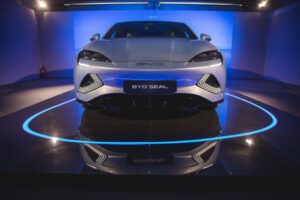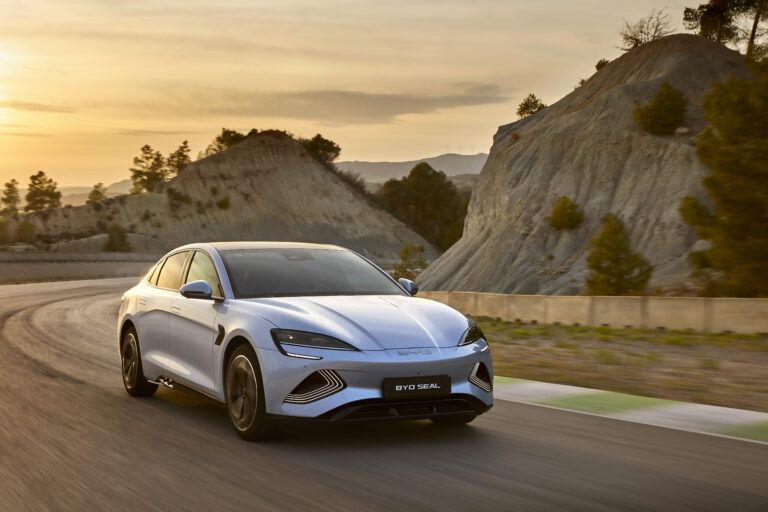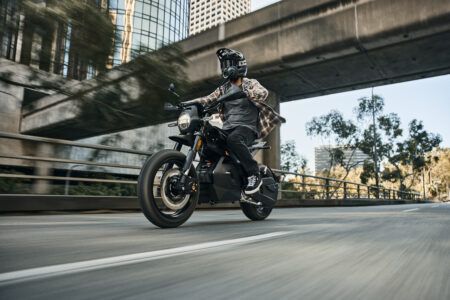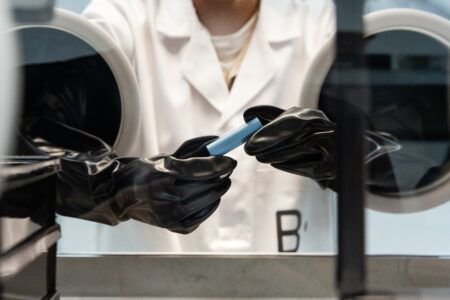“The battery no longer needs to be a vulnerable baby that you need to be careful with,” says Build Your Dream’s (BYD) Weijie Zhang, from the company’s EU R&D division. BYD introduced its Blade battery back in 2020, and behind Weijie is a video of a 50-tonne truck driving over the company’s battery. BYD is quick to point out, too, that the pack passes the tough nail penetration test – where it didn’t emit smoke or fire, with the surface temperature reaching just 30-60 degrees. It’s also been over charged by 260%, crushed, bent, and heated to 300 degrees in a furnace, without combusting, BYD’s abuse of the Blade being comprehensive, to provide the greatest safety possible.
Using lithium-ion phosphate as its cathode material the Blade is cobalt free, it features CTP (Cell to Pack Technology) construction with a honeycomb structure which BYD claims increases space utilisation by as much as 50% to provide greater power density in relation to dimensions.
In line with Weije’s comment, the BYD Blade battery isn’t just a power pack, but is also a structural element, BYD’s power dense, compact battery is able to be assembled directly to the frame as a stressed element. It’s housed in BYD’s new e-Platform 3.0, with Cell to Body (CTB) technology, the pack is integrated directly into that structure. It means the top cover of the Blade battery creates the passenger compartment floor, with the battery actually being part of the crash structure that contributes to the force transmission and energy absorption of the vehicle. As an example of the success of that integration, Blade and e-Platform 3.0 has, claims BYD, reduced intrusion during side pole testing by as much as 45%.
With the company stating that, ‘safety is the ultimate luxury for electric vehicles’ that’s significant, while it also brings clear packaging advantages, BYD’s solution removing around 10-15mm gap that would more normally feature between a battery top cover and the floor. This affords BYD’s e-Platform 3.0 vehicles to be able to offer ‘premium levels of space in the passenger cabin’ yet achieve that while still providing the sort of low-slung sporting aesthetic that BYD wants to aid a range-friendly drag co-efficient, indeed, the Seal is rated at just 0.219.

Dolphin and Seal
The Seal is BYD’s new d-segment saloon and is one of two pre-production cars underpinned by the scalable e-Platform 3.0 that BYD has brought along to the Spanish ParcMotor test track. The smaller C-segment hatchback, Dolphin, joins it, as BYD prepares the two models for European introduction. The two cars highlight the versatility of BYD’s e-Platform 3.0, with the Seal being all-wheel drive (AWD) or rear-wheel drive (RWD) with the dual motors of the AWD Seal producing 390kW and power from its Blade battery rated at 82kWh. That’s enough, in the AWD model to allow the Seal to reach 62mph in just 3.8 seconds, with BYD stating a WLTP combined range figure of 520km (322 miles) for that dual motor car, charging possible via 150kW DC/11kw AC connections, for a 26 minute 30-80% charge time possible with the higher input.
Conversely, the Dolphin is front-wheel drive via a 150kW motor, powered by a 60kWh pack (a smaller battery choice will be offered), with the focus here more on practicality than performance; 62mph arriving in 7.1 seconds and a WLTP combined range of 427km (265 miles). Charging power for the Dolphin is rated at 11kW SC and 88kW DC, the latter allowing a potential 30-80% charge in 29 minutes.
The efficiency of both is aided by a number of BYD features with the e-Platform 3.0, with both cars coming with a direct heating and cooling system for the batteries, which the company claims increases the thermal efficiency by as much as 20% in the winter. The high efficiency heat pump, which allows operation in a temperature range from -30 degrees Celsius to 60 degrees, works alongside BYD’s 8-in-1 electric powertrain. This powertrain integrates the Vehicle Control Unit, the battery management system, power distribution unit, drive motor, motor controller, inverter, transmission, DC-DC, and on-board charger, with the combination delivering a system efficiency of 89%.

Dreaming the build
The motor’s efficiency is rated at 97.5%, it utilizes a flat wire winding and using an in-house SiC motor controller, this again being claimed to the benefit of energy losses – by as much as 70%. The BYD developed operating system which controls all the cars’ functions decouples the hardware and software to aid expansion of functions, be readily upgradeable and is open source for developers.
BYD might have started out as a battery manufacturer, but so far it has sold over 3.7 million new energy vehicles worldwide. Such is BYD’s commitment to new energy vehicles it has stopped production of fossil fuel vehicles. Unlike traditional manufacturers BYD isn’t reliant on outside supplies, either, with the only components it doesn’t produce itself for its vehicles being glass and tyres.
That ownership of the entire car system production and development is advantageous, allowing BYD to develop its technology to suit its particular goals. In relation to the driving characteristics. With the new platform the company has added what it describes as Intelligent Torque Adaption Control (ITAC) which takes advantage of faster and more accurate measurement of motor speeds instead of the more traditional wheel speed sensing via brake information. Doing so enables faster more precise torque distribution, to the benefit of both dynamic ability and also safety. Added to BYD’s statement that the e-Platform 3.0 gives the Seal torsional stiffness of 40500Nm per degree and it’s obvious why the company has laid out a tight slalom course on the test track we’re visiting today.
Driving time is very limited, and only on the circuit, but BYD’s claims aren’t without substance, with the Seal feeling agile and precise, with great stability, as well as impressive performance. The Dolphin, with its differing goals isn’t quite as interesting to drive, but what’s evident is that both cars are more than just competent alternatives in the burgeoning EV marketplace, with the Seal in particular being good enough to take on and beat the established class leaders. With the e-Platform, Blade battery and its drivetrain components all scalable BYD’s model proliferation is set to continue, and expand into more markets as it does so, which is certain to keep its 10,000+ automotive engineering team very busy indeed.





